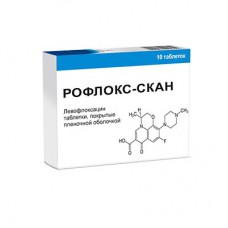Expiration date: 04/2025
Formdata
Roblox-Scan - synthetic antibacterial broad-spectrum drugs of the fluoroquinolone group containing, as the active substance levofloxacin - levo isomer of ofloxacin.
Levofloxacin does DNK-girazu and topoisomerase IV, violates supercoiling and cross-linking of DNA breaks, inhibits DNA synthesis, causes profound morphological changes in cytoplasm, cell wall and membranes of microbial cells. Levofloxacin is active against most strains of microorganisms, both in vitro and in vivo.
In vitro
Sensitive microorganisms (IPC <= 2 mg/l; the zone of inhibition of >=17 mm)
- Aerobic gram-positive microorganisms: Bacillus anthracis, Corynebacterium diphtheriae, Corynebacterium jeikeium, Enterococcus faecalis, Enterococcus spp., Listeria monocytogenes, Staphylococcus coagulase-negative methi-S(I) [coagulasenegative methicillin-chuvstvitelny/-moderately sensitive)], Staphylococcus aureus methi-S (methicillin-chuvstvitelny), Staphylococcus epidermidis methi-S (methicillin-sensitive) Staphylococcus spp. CNS (coagulasenegative), Streptococci spp. C and G, Streptococcus agalactiae, Streptococcus pneumonia peni I/S/R (penicillin-sensitive moderate/sensitive/-resistant), Streptococcus pyogenes, Viridans streptococci penis/R (penicillin-sensitive/resistant).
- Aerobic gram-negative microorganisms: Acinetobacter baumannii, Acinetobacter spp., Actinobacillus actinomycetemcomitans, Citrobacter freundii, Eikenella corrodens, Enterobacter aerogenes, Enterobacter cloacae, Enterobacter spp., Escherichia coli, Gardneirella vaginalis, Haemophilus ducreyi, Haemophilus influenzae ampi-S/R (ampicillin-sensitive/resistant), Haemophilus parainfluenzae, Helicobacter pylori, Klebsiella oxytoca, Klebsiella pneumonia, Klebsiella spp., Moraxella catarrhalis ss+/ss- (and reproducirse producing beta-lactamase), Morganella morganii, Neisseria gonorrhoeae non PPNG/PPNG (reproducirse and producing penicillinase), Neisseria meningitidis, Pasteurelia canis, Pasteurella dagmatis, Pasteurella multocida, Pasteurella spp, Proteus mirabilis, Proteus vulgaris, Providencia rettgeri, Providencia stuartii, Providencia spp., Pseudomonas aeruginosa (hospital infections caused by Pseudomonas aeruginosa may require combined treatment), Pseudomonas spp., Salmonella spp., Serratia marcescens, Serratia spp.
Anaerobic microorganisms: Bacteroides fragilis, Bifidobacterium spp., Clostridium perfringens, Fusobacterium spp., Peptostreptococcus, Propionibacterium spp., Veillonella spp.
- Other organisms: Bartonella spp. Chlamydia pneumoniae, Chlamydia psittaci, Chlamydia trachomatis, Legionella pneumophila, Legionella spp., Mycobacterium spp. Mycobacterium leprae, Mycobacterium tuberculosis, Mycoplasma hominis, Mycoplasma pneumoniae, Rickettsia spp. Ureaplasma urealyticum.
Moderately susceptible organisms (IPC = 4 mg/l; the zone of inhibition 16-14 mm)
- Aerobic gram-positive microorganisms: Corynebacterium past, Corynebacterium xerosis, Enterococcus faecium, Staphylococcus epidermidis methi-R (methicillin-resistant), Staphylococcus haemolyticus methi-R (methicillin-resistant).
- Aerobic gram-negative microorganisms: Campylobacter jejuni/coli
Anaerobic microorganisms: Prevotella spp., Porphyromonas spp.
Resistant to levofloxacin microorganisms (IASC >= 8 mg/l; the zone of inhibition of <= 13 mm):
- Aerobic gram-positive microorganisms: Staphylococcus aureus methi-R (methicillin-resistant), Staphylococcus coagulase-negative methi-R (coagulasenegative methicillin-resistant).
- Aerobic gram-negative microorganisms: Alcaligenes xylosoxidans.
Anaerobic microorganisms: Bacteroides thetaiotaomicron.
- Other microorganisms: Mycobacterium avium.
Resistance
Resistance to levofloxacin occurs as a result of a gradual process of mutations of the genes encoding both type II topoisomerase: DNA-girazu and topoisomerase IV. Other mechanisms of resistance such as the mechanism of influence on the penetration barriers to microbial cells (specific for Pseudomonas aeruginosa) and the mechanism of efflux (active excretion antimicrobial agents from microbial cells), can also decrease the sensitivity of microorganisms to levofloxacin.
In connection with the peculiarities of the mechanism of action of levofloxacin is usually not observed cross-resistance between levofloxacin and other antimicrobial agents.
The clinical efficacy (efficacy in clinical trials in the treatment of infections caused by the following microorganisms)
Aerobic gram-positive microorganisms: Enterococcus faecalis, Staphylococcus aureus, Streptococcus pneumoniae, Streptococcus pyogenes.
- Aerobic gram-negative microorganisms: Citrobacter freundii, Enterobacter cloacae, Escherichia coli, Haemophilus influenzae, Haemophilus parainfluenzae, Klebsiella pneumoniae, Moraxella (Branhamella) catarrhalis, Morganella morganii, Proteus mirabilis, Pseudomonas aeruginosa, Serratia marcescens.
- Others: Chlamydia pneumoniae, Legionella pneumophila, Mycoplasma pneumoniae.
Pharmacokinetics
Absorption
Levofloxacin is rapidly and almost completely absorbed after ingestion, food intake has little effect on its absorption. The absolute oral bioavailability is 99-100%. After a single dose of 500 mg of levofloxacin maximum concentration in plasma (Cmax) is achieved within 1-2 h and is 5, 2±1, 2 µg/ml the Pharmacokinetics of levofloxacin are linear in the dose range of about 50 to 1000 mg. Equilibrium concentration of levofloxacin in plasma at the dose of 500 mg of levofloxacin 1 or 2 times a day achieved within 48 hours.
On day 10 of ingestion of 500 mg of levofloxacin 1 time per day Cmax of levofloxacin was 5, 7±1, 4 µg/ml and minimum concentration of levofloxacin (concentration before taking another dose) in plasma (Cmin) were 0, 5±0, 2 mg/ml.
On day 10 of ingestion of 500 mg of levofloxacin 2 times a day, the Cmax of levofloxacin was 7, 8±1, 1 µg/ml, a Cmin - 3, 0 ±0, 9 ug/ml.
Distribution
Relationship with serum proteins is 30-40%. After a single and a repeated dose of 500 mg of levofloxacin volume distribution levofloxacin is an average of 100 l, which indicates good penetration of levofloxacin in tissues and organs of the human body.
Penetration into bronchial mucosa, epithelial lining fluid, alveolar macrophages
After a single oral administration of 500 mg of levofloxacin maximum concentration of levofloxacin in bronchial mucosa and epithelial lining fluid was achieved within 1 h or 4 h and were 8, 3 µg/g and 10 8 µg/ml, respectively, with coefficients of penetration into the mucosa of the bronchi and epithelial lining fluid compared to the concentration in plasma, components 1, 1-1, 8, and 0, 8-3, respectively.
After 5 days of ingestion of 500 mg of levofloxacin the average concentrations of levofloxacin after 4 hours after the last dose of the drug in liquid epithelial lining was 9, 94 µg/ml in alveolar macrophages - 97, 9 µg/ml.
Penetration in lung tissue
The maximum concentration in lung tissue after ingestion of 500 mg of levofloxacin was approximately 11, 3 µg/g and was reached after 4-6 h after administration of the drug with the penetration factors of 2-5, compared to the concentration in the blood plasma.
Penetration into the alveolar fluid
After 3 days of taking 500 mg of levofloxacin 1 or 2 times a day Maksimalna concentration of levofloxacin in the alveolar fluid were reached 2-4 hours after drug administration and was 4, 0 and 6, 7 µg/ml, respectively, with a coefficient of penetration 1, compared with concentrations in blood plasma.
Penetration into bone tissue
Levofloxacin penetrates well into cortical and cancellous bone in the proximal and in the distal femur with a coefficient of penetration (bone tissue/plasma) 0, 1-3. The maximum concentration of levofloxacin in the cancellous bone of the proximal femur after taking 500 grams of the drug inside was about 15 and 1 µg/g (2 hours after taking the drug.)
Penetration into the cerebrospinal fluid
Levofloxacin poorly penetrates into the cerebrospinal fluid.
Penetration into the prostate tissue
After ingestion of 500 mg of levofloxacin 1 time per day for 3 days, the average concentration of levofloxacin in the prostate tissue was 8, 7 µg/g average ratio of the concentrations of the prostate/blood plasma was 1, 84.
Concentration in the urine
The average concentrations in the urine after 8-12 hours after ingestion of doses of 150, 300 and 600 mg levofloxacin were 44 mg/ml 91 µg/ml 162 µg/ml, respectively.
Metabolism
Levofloxacin is metabolized to a small extent (5% of dose). Its metabolites are dimethylsiloxane and N-oxide levofloxacin, which are excreted by the kidneys. Levofloxacin is stereochemically stable and subjected to chiral transformations.
Excretion
After oral levofloxacin is relatively slowly eliminated from plasma (half-life period (T1/2) of 6-8 h). Excretion is mainly through kidney (more than 85% of the dose). Total clearance of levofloxacin after a single dose of 500 mg was 175±29, 2 ml/min.
No significant differences in the pharmacokinetics of levofloxacin when it was administered intravenously and ingestion, which confirms that the oral and intravenous administration are interchangeable.
Pharmacokinetics in specific groups of patients
The pharmacokinetics of levofloxacin in men and women did not differ.
Pharmacokinetics in elderly patients does not differ from that in younger patients, with the exception of differences in the pharmacokinetics associated with differences in creatinine clearance (CC).
In renal insufficiency the pharmacokinetics of levofloxacin is affected. reduce kidney excretion through the kidneys and renal clearance (ClR) decreased, and T1/2 increases.
Pharmacokinetics in renal insufficiency after a single oral administration of 500 mg of levofloxacin.
Testimony
Bacterial infections that are sensitive to levofloxacin, adults:
- acute sinusitis;
- exacerbation of chronic bronchitis;
- community-acquired pneumonia;
- uncomplicated urinary tract infection;
- complicated urinary tract infections (including pyelonephritis);
- chronic bacterial prostatitis;
- infection of the skin and soft tissues;
- for the treatment of drug-resistant forms of tuberculosis;
- prevention and treatment of anthrax in an airborne way of infection;
- hospital-acquired pneumonia (dosage 750 mg).
In applying the drug Roflex-Scan should be considered the official national guidelines on appropriate use of antimicrobial drugs, as well as the sensitivity of pathogenic microorganisms in the specific country (see "Special instructions").
Contraindications
- hypersensitivity to levofloxacin or to other hinolonam, as well as to any of the excipients of the drug Reflex-Scan;
- epilepsy;
- psevdoparalitichesky myasthenia gravis (myasthenia gravis) (see "Side effects", "Special instructions");
- the defeat tendons when taking fluoroquinolones in anamnesis;
- child and adolescence to 18 years (due to the incomplete growth of the skeleton, as it is impossible to completely eliminate the risk of failure of the cartilaginous growth points);
- pregnancy (it is impossible to completely eliminate the risk of destruction of the cartilaginous points of growth in the fetus);
- breastfeeding (it is impossible to completely eliminate the risk of destruction of the cartilage of the growth points of bones in children).
With caution:
- Patients predisposed to the development of seizures [in patients with prior Central nervous system (CNS) in patients receiving both drugs that reduce the seizure threshold of the brain, such as fenbufen, theophylline] (see section "Interaction with other medicinal products").
- Patients with latent or manifestating the deficit glukozo-6-fosfatdegidrogenaza (increased risk of hemolytic reactions in the treatment hinolonami).
- In patients with impaired renal function (require mandatory monitoring of kidney function, and a correction mode, see "Method of application and dosage").
- Patients with known risk factors for the lengthening of the interval QT: elderly patients; female patients; patients with uncorrected electrolyte disorders (hypokalemia, hypomagnesemia); syndrome of congenital lengthening of interval IT; with heart disease (serdeczna failure, myocardial infarction, bradycardia); while admission
- medicines that can prolong the QT interval (antiarrhythmic class IA and III, tricyclic antidepressants, macrolides, antipsychotics) (see "Overdose", "Interaction with other medicinal products", "Special instructions").
- Patients with diabetes receiving oral hypoglycemic agents such as glibenclamide or insulin (risk of hypoglycemia).
- Patients with severe adverse reactions to other fluoroquinolones, such as severe neurological reactions (increased risk of similar adverse reactions with the use of levofloxacin).
- In patients with psychosis or in patients with a history of mental illness.
Dosing
Pills Reflex-Scan, 250 mg, 500 mg or 750 mg taken orally once or twice a day. The tablets should be swallowed with liquid squeezed enough liquid (from 0, 5 to 1 Cup). If necessary, tablets may be broken at risk. The drug can be taken before a meal or anytime between meals, because food intake does not affect absorption of the drug (see section "Pharmacokinetics").
The drug should be taken at least 2 h before or 2 h after administration of preparations containing magnesium and/or aluminum, iron, zinc, or sucralfate (see section "Interaction with other medicinal products").
Given that the bioavailability of levofloxacin in drug Reflux-Scan tablets equal to 99-100 % in the case of transferring a patient with an intravenous infusion of the drug Reflex-Scan on the medication, you should continue treatment with the same dose as that used in intravenous infusion (see "Pharmacokinetics").
Skipping one or more doses of the drug
If you accidentally missed a dose, it is necessary as soon as possible to take another dose and continue to take the drug Roflex-Scan mode according to the recommended it dosing.
Dose and duration of treatment
The dosage is determined by the nature and severity of the infection, and the alleged sensitivity of the pathogen. The duration of treatment varies depending on the disease.
The recommended dosing regimen and duration of treatment in patients with normal renal function (QC> 50 ml/min)



